Gasch R., Twele J. (Eds.) Wind Power Plants: Fundamentals, Design, Construction and Operation
Подождите немного. Документ загружается.

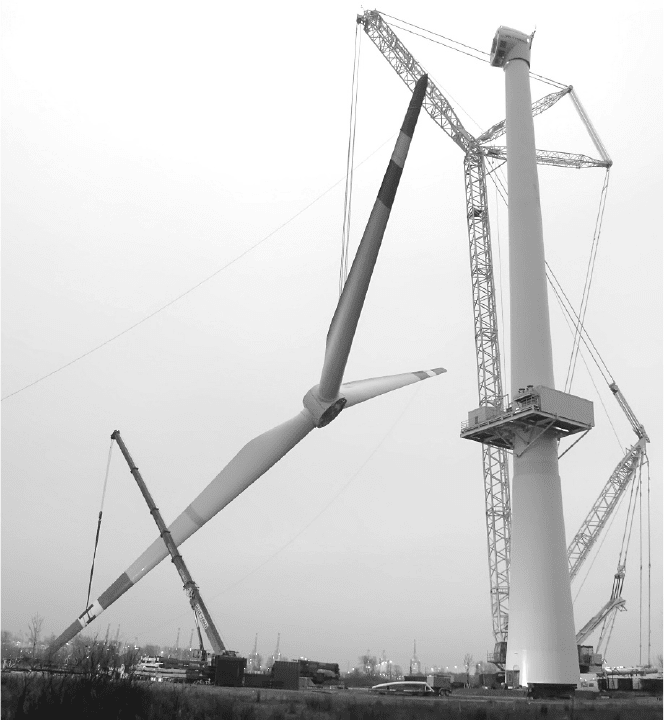
502 15.2 Erection and operation of wind turbines
appears to an onlooker to have been finally erected. However, several days of
work will have to be spent for completing the internal installations and the con-
nections before initial operation.
Fig. 15-13 Hoisting the Rotor by means of main mobile crane and assisting mobile crane [9]
According to the German Renewable Energy Sources Act, the feed-in tariff valid
for the individual wind turbine is determined by the date of the first electricity
feed into the grid. Since the feed-in tariffs are usually reduced from year to year, it
may be essential to set the wind turbine at least shortly into operation already in
the end of December to get the higher tariff. This explains, among others, why the
number of installed wind turbines is usually higher in the second half of the year
than in the first half of the year despite the more unfavourable weather conditions
for installation.
15 Planning, operation and economics of wind farm projects 503
Commissioning and take-over
Several weeks of testing usually pass between the production of the first kilowatt-
hour of electricity and the handing over of the wind turbine to the operator. The
future operator/operational manager of the wind turbine checks himself or
arranges for an inspection to take place in order to see whether the wind turbine
was delivered and erected as agreed by contract and to ensure it proper and fault-
less functioning.
The common procedure is:
- Test operation, surveyed by the manufacturer and adjustment of parame-
ters to the site-specific conditions
- Inspection and elimination of deficiencies by the manufacturer
- Acceptance inspection and handing-over to the operator or operational
manager which defines the begin of the defect liability period
After the elimination of “childhood diseases“ (e.g. rotor unbalance) and the final
adaption of control parameters to the site conditions, the wind turbine is officially
commissioned and handed over tot the operator. An independent expert usually in-
spects the wind turbine for the operator to check and clarify whether the specifica-
tions of the contract have been all fulfilled. This inspection involves checking the
technical condition of the wind turbine itself, as well as its auxiliary installations
such as aviation safety markings or lights, a possibly modified power curve for the
reduction of noise emission and so on. The requirements of the building permit are
of prime importance in this context.
Wind turbine operation
Operation and inspection
The wind turbine shall now operate for a minimum of 20 years with the highest
possible availability. The technical operator surveys all technical aspects of the
wind farm project. After expiration of the defect liability period, any risks arising
from the operation have to be borne by the operator, as well the costs for mainte-
nance and repair if there is no full-service contract.
The safe operation of technical systems as a wind turbine has to be verified
through periodical inspections of all mechanical and electrical components and
testing their proper functioning. Moreover, the safety equipment for climbing the
tower (ladder, lift, harness, rescue devices, etc.) is checked and all other aspects
that are related to potential risks, such as fire hazard, environmentally hazardous
materials, machine damage, etc.
504 15.2 Erection and operation of wind turbines
In Germany, it is required that wind turbines are checked every two to four years
by an independent expert. The interval depends on the wind turbine size and
whether a service contract exists for the wind turbine. The aim is to minimise dan-
ger to the environment, humans and the machine itself, or to reduce these risks to
an accountable degree at least.
High availability and high yield are irrelevant in the context of safety; however,
these two issues are of upmost importance for the operator Hence, a “condition-
oriented inspection” of the wind turbine should be carried out. All components are
inspected to see whether faults, malfunction defects or damages announce or have
already occurred. The focus is primarily on bearings and gearbox. Based on the
recommendations of the inspection report, the operator decides whether mainte-
nance, repair or even component exchange is necessary, e.g. of a bearing of the
generator.
Full-service contracts offered by wind turbine manufacturer with the manufac-
turer continuing to be responsible for maintenance and repair of the wind turbine
also provide an alternative. However, in this case as well, it is still the duty of the
technical operator to care about a reliable operation with high availabilities and
maximised energy yield. The following has to be surveyed by the technical
operator:
- Operation during the defect liability period,
- Handing-over at the end of the defect liability period according to the
purchase contract (usually 2 to 3 years),
- Operation after the expiration of the defect liability period,
- Maintenance and repair and
- Inspection and control of the operation.
Maintenance and repair
The necessary service works and intervals are documented in the technical specifi-
cations of the wind turbine. All bearings have to be lubricated periodically. All
mechanical components, electrical devices and control components have to be
maintained. Small repairs are carried out without delay. The technical operator
will then be given a service protocol.
The operator is responsible for successful operation of the wind farm, but there
is often a separate technical wind farm manager caring for technical tasks of
O&M. Apart from a very good technical knowledge of wind turbines this person
needs to be able to communicate in a clear and effective manner with the (more
economically oriented) wind farm management team and all the other external
partners concerned: wind turbine manufacturer, service companies, grid operator,
inspectors and other experts, authorities, and so on. The duties are:
15 Planning, operation and economics of wind farm projects 505
- Collection and management of all technical information (e.g. contracts,
manuals, circuit diagrams, etc.),
- Remote monitoring of the wind turbine operation (e.g. energy production
measured at the electricity meter, status messages and permanently
recorded operating data),
- Regular visits to the wind turbines and wind farms for visual inspections
- Organisation and survey of service and repair works,
- Generation of periodical reports on successful operation (energy yield
and availability) and technical condition (malfunction and repair) and
- Improvement and optimisation of wind turbine operation for increased
availability and energy yield
Acquisition of operating data and condition monitoring
Wind turbines run usually in an automatic operation mode and are controlled by
the internal supervisory and control computer. Typically, communication with the
control room of the wind turbine manufacturer or the technical wind farm manager
will be initiated only in the event of malfunction. Then, the wind turbine sends an
email, fax or sms, and the service team has to take action.
Furthermore, the wind turbine stores its operating data, which includes current
wind speed, wind direction, rotational speed, electrical power, several tempera-
tures and further operational parameters. These can be read out with the System
Control And Data Acquisition Software (SCADA) and are the data on which the
technical wind farm manager bases his assessment of the wind turbine condition
and any measures that may need to be carried out.
Fig. 15-14 shows the yield data versus the wind speed measured with the nacelle
anemometer for a six-month period of operation. The 10-minute averages of the
electrical power are sorted into wind speed class bins, forming the real energy his-
togram which shows the energy yield per wind class (cf. section 4.3). For com-
parison, the theoretical energy histogram is also displayed. This is calculated from
the measured wind speeds (i.e. the measured wind histogram) and the power curve
of the wind turbine manufacturer. The differences are clearly visible, not only be-
tween the histograms but also between the theoretical and real power curve which
provides valuable information on site quality and wind turbine operation.
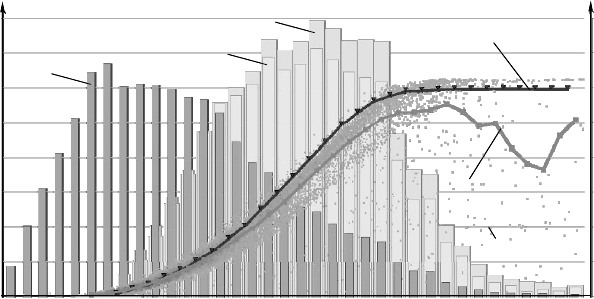
506 15.2 Erection and operation of wind turbines
0
500
1000
1500
2000
Electrical power in kW
0
Frequency in %
2
4
6
8
024 6 810121416
Theoretical energy histogram
Real energy histogram
Power curve of contract
Wind
histogram
Power curve from
operation data
Operating
points
Wind speed in m/s
0
500
1000
1500
2000
Electrical power in kW
0
Frequency in %
2
4
6
8
024 6 810121416
Theoretical energy histogram
Real energy histogram
Power curve of contract
Wind
histogram
Power curve from
operation data
Operating
points
Wind speed in m/s
Fig. 15-14 Operating data of a wind turbine [11]
The analysis of the operating data reveals the efficiency of operation. Malfunction
statistics and trend analysis provide information on problems arising with certain
components. The prevention of damages can be improved by installing a condition
monitoring system (CMS). By vibration measurements, the condition of the main
drive train components bearings and gear box is permanently monitored and
assessed in order to prevent a machine breakdown with possible consequential
damages. Moreover, scheduling repair or replacement of the affected component
is facilitated, i.e. deciding whether an immediate component replacement is neces-
sary or whether there is enough useful life remaining for waiting with the works
until the end of the windy season). The CMS offers the better alternative to periodical
short-time measurement and assessment by an expert but it requires some invest-
ment costs.
Insurances for wind turbines
The types of risks and who is to bear them are the most important questions for in-
surance companies. The manufacturer alone bears all risks before installation or
handing-over of the wind turbine to the operator. In all phases of the wind farm
project – from production and transport to the years-lasting operation – there is the
risk that proper operation may be disturbed or interrupted by unexpected events.
The wind turbines have to be insured against machine breaking and external dan-
gers (fire, lightning, etc.).
Additionally, it is advisable be insured against operation interruption to compen-
sate for yield loss during downtimes. In some cases, the financing bank stipulates
such an insurance in order to make sure that the loan can be repaid. Practical
experience from wind turbine operation has revealed that prolonged downtimes
15 Planning, operation and economics of wind farm projects 507
following an insured event of damage (e.g. lightning strike or generator damage)
can result in significantly increased insurance costs. If the cause of a minor dam-
age (e.g. a hot running bearing) was not detected a more serious consequential
damage may result, e.g. a fire in the nacelle.
The third kind of required insurance is liability insurance. This covers events
where somebody or something is damaged by the wind turbine which may even
incluce damage due to a falling machine component or a piece of ice – or even fire
in the field below the wind turbine caused by a fire in the nacelle.
At any rate, risks which cannot be insured include the following: wear due to
operation, third party damages to the wind turbine, negligence by installation of
already defective components as well as the effects of war and accidents in
nuclear power plants.
Decommissioning and repowering of wind turbines
At the end of the operating period the wind turbine has to be decommissioned, cf.
Fig. 15-1. Another economic alternative is so-called repowering which is the re-
placement of many small wind turbines by a few bigger ones. The local options
for this should be checked carefully already in the wind farm planning because
decommissioning or repowering should be considered in the contracts.
New wind turbines are not only bigger than smaller ones. Typically, they are
more quiet and more efficient, showing higher availability and energy yield at the
same site and as well as reduced service costs. Therefore, repowering brings tech-
nical progress and economic benefits. Moreover, a few big wind turbines have a
reduced the visual impact on the landscape compared to the case of many small
wind turbines. First and foremost, repowering is a decision based on economic
considerations. Mostly, it is only economically viable after 20 years of operation.
However, several successful repowering projects in Germany have already proven
the increased economic benefit as well as the reduced visual impact.
15.2.2 Legal aspects
In order to implement the wind farm project and operate the wind turbines, it is
necessary to establish a company, cf. Fig. 15-1, since operating wind turbines im-
plies a commercial venture.
For a small wind farm with only a few participators a partnership under the
German Civil code such as a BGB company is suitable. The formation of a BGB
company does not require much effort as no formalities are involved except for
registration with the tax office. There is no need for the minimum capital or the
registration in the commercial register. However, the partners concerned are
commercially liable, meaning that they together with their entire personal assets
508 15.2 Erection and operation of wind turbines
are liable for the company. The proceeds and losses are offset against other in-
come in the income tax return.
In Germany, investment in wind farm projects has been primarily carried out
by private individuals. Therefore, the legal form of a limited liability company
should not be chosen for the operating company but rather a limited partnership
with a limited liability company as a general partner. The limited liability com-
pany is responsible for the business and technical management. Private investors
acquire the shares as limited partners in the limited partnership thus providing the
required equity. This combines the advantages of both legal company forms. Lim-
ited partners get their share of proceeds and losses in the course of a separate de-
termination of the annual accounts, declare them and are liable for the capital they
have contributed.
If the wind farm project is started as a local or regional initiative, it is often
quite easy to find investors without having to conduct a major marketing cam-
paign. A nationwide search for investors would be appropriate if investment
amounted to several hundred million Euros. A closed-end investment company is
then launched and announced in a fonds prospectus. In this case the legal frame-
work of the liability in respect of information contained in fonds prospectus has to
be observed. The given information should follow the common standards (e.g.
IDW 4, quality standard of the German Association of Certified Public Account-
ants) and have the attestation of a certified accountant.
All further legal implications (rights and duties of the limited partner, their right to
say in a matter, etc.) have to be regulated in the company contracts of the operat-
ing company.
15.2.3 Economic efficiency of operation
If the financing has been secured and the wind farm project implemented, the
revenue from the electricity sold are offset against the operation costs (cf. section
15.1.3). The legal framework of the German Renewable Energy Sources Act
(German: EEG) stipulates the feed-in tariffs per kWh which form the basis of the
20-years feed-in contract [12]. In absence of such a set regulation regarding the
feed-in tariffs, it would be difficult to finance a wind farm project as it incurs rela-
tively high investment costs. The framework of the German Electricity Feed-in
Act (German: Stromeinspeisegesetz, StrEG, 1991 to 2000) and the successor
scheme of the EEG which followed in April 2000 is internationally regarded as a
good example of a legal framework which helps to turn a wind farm project, for
favourable site conditions, into a safe and profitable capital investment. The EEG
differentiates according to site quality in order not to privilege coastal sites vis-à-
vis inland sites which have disadvantageous wind conditions through lower mean
wind speeds. Further details regarding the legal framework can be found in the
references, e.g. [8, 12].
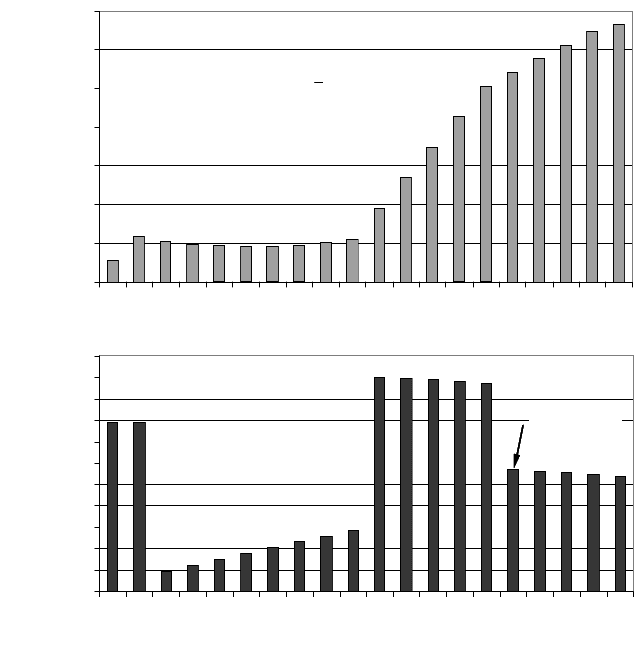
15 Planning, operation and economics of wind farm projects 509
The usual company accounts with the balance sheet and the profit and loss state-
ment are required for every year of operation. Apart from the economic develop-
ment of the wind farm project, the development of liquidity (cash) plays a decisive
role as risk of insolvency lurks in the worst-case scenario. Illiquidity would mean
that the project has failed economically. Besides operating costs (see section
15.1.3 and Figures 15-16), the debt service (interest and repayment/amortisation)
for the external financing (approx. 75%) results in large cash flows during the fi-
nancing period, usually the first ten years. In the first years, the dept service may
reach up to 2/3 of the proceeds.
0
100.000
200.000
300.000
400.000
500.000
600.000
700.000
1 2 3 4 5 6 7 8 9 1011121314151617181920
Betriebsjahr
k€
Rated power of WEC: 600 kW
Annual mean wind speed: v = 6,25 m/s
(at hub height)
Total investment: 723 000 €
Equity: 25%
Year of operation
-20.000
-10.000
0
10.000
20.000
30.000
40.000
50.000
60.000
70.000
80.000
90.000
1 2 3 4 5 6 7 8 9 1011121314151617181920
Betriebsjahr
k€
Feed-in tariff
reduction
two years
without repayment
Year of operation
k€
k€
0
LiquidityProceeds
0
100.000
200.000
300.000
400.000
500.000
600.000
700.000
1 2 3 4 5 6 7 8 9 1011121314151617181920
Betriebsjahr
k€
Rated power of WEC: 600 kW
Annual mean wind speed: v = 6,25 m/s
(at hub height)
Total investment: 723 000 €
Equity: 25%
Year of operation
-20.000
-10.000
0
10.000
20.000
30.000
40.000
50.000
60.000
70.000
80.000
90.000
1 2 3 4 5 6 7 8 9 1011121314151617181920
Betriebsjahr
k€
Feed-in tariff
reduction
two years
without repayment
Year of operation
k€
k€
0
LiquidityProceeds
Fig. 15-15 Development of the liquidity and proceeds of a wind farm project with a 600 kW
wind turbine
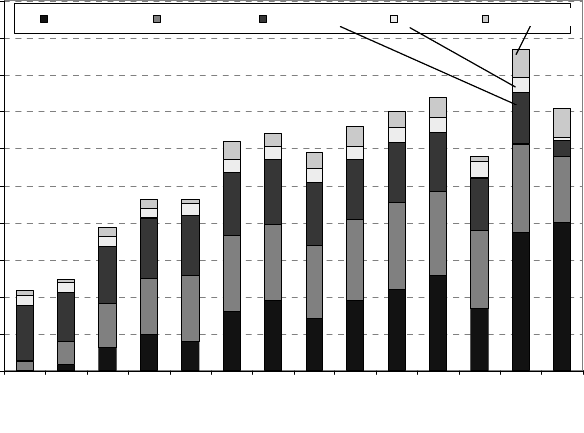
510 15.2 Erection and operation of wind turbines
Fig. 15-15, top, shows the development of the liquidity (available cash) of a sound
wind farm project. In order to build up a cash reserve it is quite useful to have two
years without repayment at the start of operation period. This is provided by the
special financing programmes of KfW Bankengruppe for renewable energy pro-
jects. This can help to bridge years which may have a negative balance due to re-
duced energy yield in bad wind years. One should avoid promptly distributing
company profits to investors so as to build up reserves for possible repairs and for
the decommissioning at the end of the project. Nevertheless, a cumulative distri-
bution of 200% to 300% at the end of the 20 years of operation is common for a
sound wind farm project.
The profit and loss statement is decisive when evaluating the annual result. Here,
in contrast to the considerations on liquidity described above, only the interest of
the debt service is considered, the repayment is not relevant, but the annual amor-
tisation is. This may lead to a loss in the first years of operation, Fig. 15-15,
below, which is then credited against the investor’s tax burden. Given the fixed
period of 16 years for amortisation (German law, 2005) the effect is quite small.
The proportion of the annual operating costs primarilys come from service, main-
tenance, repair and insurance, as discussed already in section 15.1.3. These costs
vary with the years, as shown in Fig. 15-16, and are significantly depend on the
wind turbine size.
0
5
10
15
20
25
30
35
40
45
50
1234567891011121314
Betriebsalter [Jahre]
€/kW a
Reparatur Wartung Versicherung Pacht Sonstiges
Repair Maintenance Insurance Land lease Misc.
Years of operation
0
5
10
15
20
25
30
35
40
45
50
1234567891011121314
Betriebsalter [Jahre]
€/kW a
Reparatur Wartung Versicherung Pacht Sonstiges
0
5
10
15
20
25
30
35
40
45
50
1234567891011121314
Betriebsalter [Jahre]
€/kW a
Reparatur Wartung Versicherung Pacht Sonstiges
Repair Maintenance Insurance Land lease Misc.
Years of operation
Fig. 15-16 Development of the operating costs for wind turbines with a rated power of less than
500 kW [7]
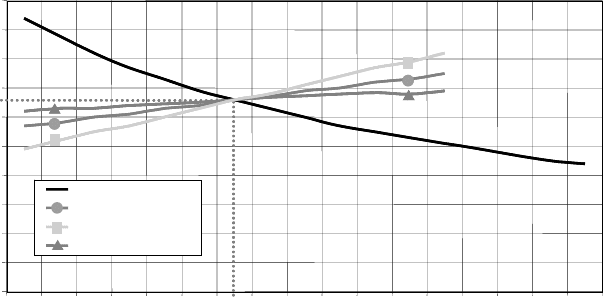
15 Planning, operation and economics of wind farm projects 511
0.000
0.010
0.020
0.030
0.040
0.050
0.060
0.070
0.080
0.090
0.100
-30-25-20-15-10-5 0 5 101520253035404550
Annual production
Interest rate
Investment costs
Operating costs
€/ kWh
Variation from base value in %
0.000
0.010
0.020
0.030
0.040
0.050
0.060
0.070
0.080
0.090
0.100
-30-25-20-15-10-5 0 5 101520253035404550
Annual production
Interest rate
Investment costs
Operating costs
€/ kWh
Variation from base value in %
Fig. 15-17 Specific electricity generation costs, sensitivity to changes of the most important
parameters [13]
Little experience has been gathered for the second decade of operation to date,
hence a conservative estimate is useful [2]. A moderate increase in operating costs
is expected due to inflation.
Fig. 15-17 summarizes the impact of the most important parameters on elec-
tricity generation costs. The effect of the operating costs is relatively low. Due to
the high share of external financing (approx. 75%) the interest level and the level
of the total investment costs are important factors. Nevertheless, there is no doubt
that the wind itself is the biggest influencing factor. Annual production depends
on the cube of the wind speed, as a result of which a 10% higher wind speed may
increase annual production by up to 30%. With respect to the example shown in
Fig. 15-17 this would result in a significant reduction in the specific electricity
generation costs from 0.065 €/kWh to 0.050 €/kWh.
15.2.4 Influence of the hub height and wind turbine concept on
the yield
The suitable wind turbine should be chosen according to the local wind conditions
so as to achieve the highest possible annual yield. First and foremost, the eco-
nomically suitable hub height has to be chosen according to the local wind profile
(increase of the wind speed with the height above ground depending on the rough-
ness length z
0
). For some wind turbines with a rated power between 1.5 and 2.5
MW, Fig. 15-18 shows the significant influence of the hub height on the area-
